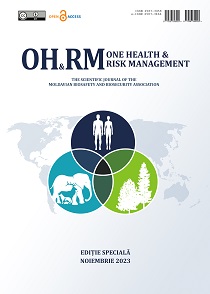Abstract
Introduction. Canids play a key role in the stability of the development cycles of a large number of parasitic species, including those with zoonotic impact. The evaluation of the population of Vulpes vulpes (Linnaeus, 1758) in the Republic of Moldova according to the number of reproductive burrows in the spring period, highlighted an increased density of foxes by 7-8 times. These animals pollute the environment with parasitic forms, which is why they pose a major danger to humans. The close human relationship with canids and the common environment can increase the risk of human infection with vector-borne zoonotic pathogens, while wild mammals in their vicinity may act as reservoirs for such pathogens. The need for this invention results from the fact that canids are usually definitive hosts of helminths and actively participate in the formation and maintenance of natural foci of parasitoses with medical and veterinary impact. Administration of drugs per os to domestic animals is done individually after their restraint.
Aim. These considerations reveal the purpose of the work, which aims to develop a new procedure to combat/reduce parasitoses in wild canids in order to strengthen bioecological and epidemiological security in natural and anthropized ecosystems.
Material and methods. The innovative process is based on the production of baits for the treatment of wild canids, as a medicinal form for rationalizing the administration of drugs to wild canids. This process includes the homogenization of food and medicinal components, extrusion and portioning into parallelepiped briquettes and as a medicinal component the antiparasitic medicine is used, according to the each bait dosage. The briquettes are individually packed in a heat-sealable filter paper bag, having the following composition: wheat flour 59.9-79.9%; meat and bone meal 10-20%; antiparasitic drug – Albendazole 0.1%; vegetable oil up to 10-20%.
Results. The results of testing the new procedure on Vulpes vulpes (Linnaeus, 1758), demonstrate that the innovative method of deworming canids, allows the successful use of baits as a medicinal form for curative and prophylactic purposes, with minimal expenses and maximum effectiveness of 94.7%. Bait as a medicinal form is successful due to the fact that it is strictly dosed and protects the active substance from the actions of environmental factors. The invented process is simple to manufacture and convenient to carry out due to the rationalization of the administration of drugs to wild canids. At the same time, it is an attractive means of consumption for animals of the content of meat meal and an element of increasing the yield and effectiveness of the treatment by simplifying the procedure of administering drugs, thus avoiding the stress of catching and containing wild animals.
Conclusions. The application advantages of this invention aiming to reduce parasitoses, including the significant reduction of damage to public health by reducing the zoonotic impact and the damage caused to the national hunting fund by reducing the impact. As a final result, there is a strengthening of bioecological and epidemiological security in natural and anthropized ecosystems.
Note: The studies were conducted within the State Program projects: 20.80009.7007.12 „Diversity of hematophagous arthropods, zoo- and phytohelminths, vulnerability, strategies for tolerating climatic factors and elaboration of innovative procedures for integrated control of species of socio-economic interest” and 20.80009.7007.02 “Evolutive changes of economically important terrestrial fauna, of rare and protected species in the conditions of anthropic and climatic modifications”
|
 Views: 115|
|
Views: 115|
|
This work is licensed under a Creative Commons Attribution 4.0 International License.

